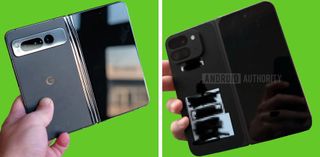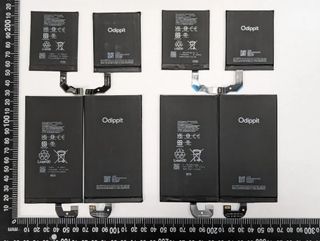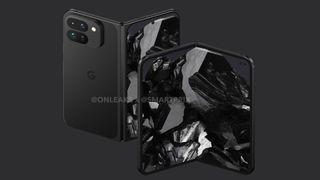Google Pixel 9 Pro Fold: Rumors, specs, and everything we expect to see
The next Google foldable is getting close.

It's almost that time of the year when we see another wave of smartphones hit the market. And, if one thing's clear, it's that there's a lot of anticipation regarding Google's next foldable and how it will differ from its predecessor. So what will we get with the Google Pixel 9 Pro Fold, and how will it improve on the fairly well-received Pixel Fold?
Fortunately, we've learned quite a bit about the upcoming foldable, which we'll detail in this article, but make sure to keep checking back for any new information as we get closer to the launch.
Google Pixel 9 Pro Fold: Price and availability
Unless Google manages to provide a bit of "shock and awe," we don't expect much to change in the way of pricing for the Pixel 9 Pro Fold. This means that we're probably looking at a starting price tag of $1,800 for the base model. And you'll have to pay a bit more if you want more storage, as the Pixel Fold's 512GB model is $120 more than the 256GB version.
As for availability, there's a lot that's still up in the air. Last year's Pixel Fold debuted at Google I/O 2023 before going on sale in June 2023. Google I/O 2024 is right around the corner, but things are likely to go differently this time around. Instead, Google confirmed that its next foldable will launch on August 13, debuting alongside the rest of the Pixel 9 series.
Google Pixel 9 Pro Fold: Design and displays

Unlike its contemporaries, Google could change things up as the Pixel 9 Pro Fold is unlikely to retain the same design as its predecessor. Instead of the now-iconic camera bar housing across the back, leaks and renders point to a drastic change. Thanks to Google's promo video, we know that the Pixel 9 Pro Fold will use a smaller rectangular camera "block," complete with dual-stacked camera sensor cutouts.
There are also said to be slight changes to the overall design, as Google could pull some inspiration from the OnePlus Open. The current iteration features curved edges across the board, while the 9 Pro Fold might ditch the curves in favor of flat edges. Similar changes are expected to come to the Pixel 9 series, although Google has already started using a flatter display on the Pixel 8 Pro.




After an alleged Pixel 9 Pro Fold photo made its rounds, this seemingly confirmed the design changes that are on the way. These also provided us with some measurements, as the leaked device reportedly measures "155.2 x 150.2 x 5.27mm when open and 155.2 x 77.1 x 10.54mm when folded." By comparison, the current Pixel Fold is 5.8mm when open and 12.1 when folded.
Be an expert in 5 minutes
Get the latest news from Android Central, your trusted companion in the world of Android
As for the displays, it seems that we're in for a larger device overall. According to Ross Young, Google will use a 6.29-inch cover screen and an 8.02-inch inner display. Both of these are an increase over the 5.8-inch and 7.6-inch displays found on the current Pixel Fold.
Google Pixel 9 Pro Fold: Specs and performance

Arguably the biggest reason why Google might wait until the Fall to debut its next foldable phone is due to the chipset. If rumors are to be believed, the Pixel 9 Pro Fold will skip the Tensor G3 altogether, in favor of the Tensor G4. To some, this move makes more sense than what we saw with last year's model.
Google released the Pixel Fold with the Tensor G2, which was unveiled in the Fall of 2022. However, just a few months later, the Tensor G3 was introduced alongside the Pixel 8 family. Google's Tensor G3 in the Pixel 8 Pro brought with it Gemini Nano compatibility for more AI-powered features. Meanwhile, the Pixel Fold has largely been left in the dust despite costing as much as $1,000 more than the Pixel 8 and 8 Pro.
The Tensor G4 isn't expected to be a game-changer for the smartphone market, offering an incremental upgrade over the G3. However, when you consider that the Pixel Fold is already a generation behind, the upgrades will be more substantial.
Rumors suggest Google will offer 16GB of RAM and 256GB of storage in addition to the Tensor G4. At least in terms of RAM, this is an increase over the 12GB found in the Pixel Fold. We suspect Google will also offer the Pixel 9 Pro Fold with either 256GB or 512GB of storage, but it's unknown whether a 1TB model will be on the table.

As for battery life, it seems that the Pixel 9 Pro Fold will actually feature a smaller battery than the original Pixel Fold. After the device passed through the NCC in Taiwan, the listings revealed a 4,560mAh cell for Google's next foldable. This is being achieved by using dual-battery technology often seen in foldable phones, with a 1,183mAh and 3,377mAh combination.
Google Pixel 9 Pro Fold: Cameras

Besides the aforementioned design changes to the rear camera module, hardly any other information has been leaked regarding the Pixel 9 Pro Fold's camera hardware. For reference, the original Pixel Fold is comprised of five cameras. It's headlined by a 48MP primary wide-angle lens alongside a 10.8MP ultrawide lens and a 10.8MP telephoto camera. From there, we have an 8MP camera on the inner screen, while the cover screen uses a 9.5MP sensor.
One other change that we have been able to draw from the leaked renders is that Google could introduce an under-display selfie camera on the inner screen. It's likely to look similar to what we have in other foldable phones, such as the Galaxy Z Fold 5 and OnePlus Open. In doing so, the Pixel 9 Pro Fold would be able to ditch the unsightly frame found bordering the inner display.
Google Pixel 9 Pro Fold: Wishlist

While the rumor mill looks to be churning up something good for the Pixel 9 Pro Fold, that doesn't mean there aren't still things we want to see. Here are a few of our "wishlist" items that Google will hopefully check off when its next foldable phone is unveiled.
Google needs to treat it like a flagship
The Pixel 9 Pro Fold will launch alongside the Pixel 9 and 9 Pro, which is currently set to happen on August 13. If rumors are to be believed, this is due to Google opting to use the Tensor G4 as opposed to the G3 in its next foldable phone. In doing so, this would put it at the front of the line in Google's lineup of phones, whereas the Pixel Fold ended up sitting somewhere between the Pixel 8 Pro and Pixel 7a.
This decision resulted in the Pixel Fold being left out of the "fun" surrounding Google's Gemini Nano functionality. It also left a bad taste for those who paid the $1,800 price tag, only to miss out on features that are available on phones that are much less expensive.
We're keeping our fingers crossed that Google makes the right decisions with the Pixel 9 Pro Fold, and treats it as a proper flagship device. Otherwise, we wouldn't be surprised if the Pixel 9 Pro Fold is the last foldable to come out of Mountain View.
Stylus support
If there's one thing that Samsung got right with the Galaxy Z Fold series, it's the built-in stylus support. Of course, this wasn't actually introduced until the Galaxy Z Fold 3, but every model since supports the use of an S Pen. It's one area of improvement we'd like to see Google make, as there are times when using a stylus just makes more sense on the tablet-like inner display.
Qi2 and faster charging
It's been five months since the Qi2 standard was officially "launched," yet we have yet to see any phones actually released with it. With Qi2, you're able to enjoy the world of MagSafe accessories without needing to slap a magnetic ring on the back of your phone. We hoped to see Qi2 arrive in the Pixel 8 lineup, but it just wasn't meant to be. So now, we're crossing our fingers that it will make its way into the Pixel Fold 2.
Along with being able to use magnetic attachments, Qi2 also improves charging thanks to the magnetic alignment. In doing so, it's possible for phones to support at least 15W charging speeds. Along with faster wireless charging speeds, we'd like to see Google improve wired charging, as the current Pixel Fold tops out at 30W.
PWM-friendly displays
This last item on our wishlist doesn't affect very many people, but it does affect our own Nick Sutrich. Despite being a fan of foldable phones, he's been unable to enjoy the fruits of Google's labor with the Pixel Fold. Recently, he tried using the Fold only for that to last "like ten minutes, leaving him feeling as though he were going to be sick.
Unfortunately, many of the best Android smartphones are not sensitive to the issues surrounding PWM. There are a few phones that don't, but the list is shrinking by the day. Google should do whatever it can in order to accommodate all potential buyers, and not just the majority of the market.

Andrew Myrick is a Senior Editor at Android Central. He enjoys everything to do with technology, including tablets, smartphones, and everything in between. Perhaps his favorite past-time is collecting different headphones, even if they all end up in the same drawer.
